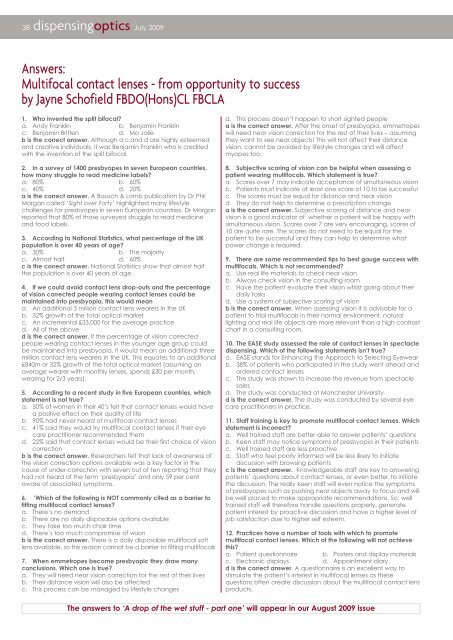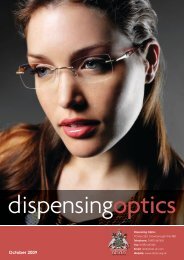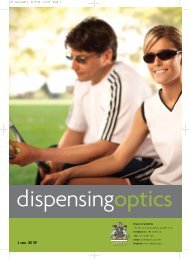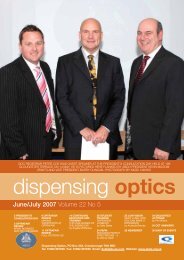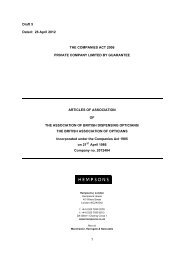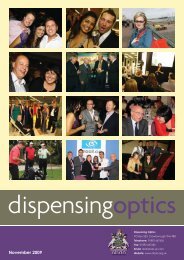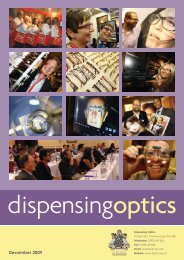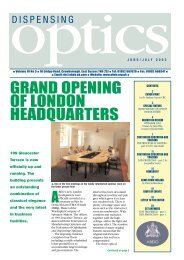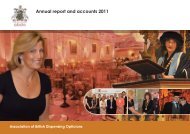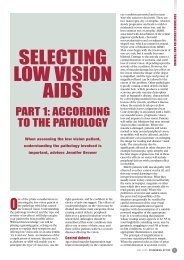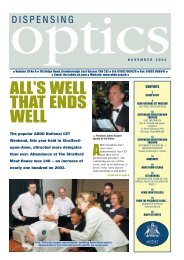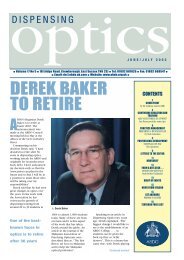Dispensing Optics - ABDO
Dispensing Optics - ABDO
Dispensing Optics - ABDO
Create successful ePaper yourself
Turn your PDF publications into a flip-book with our unique Google optimized e-Paper software.
38 dispensingoptics July 2009<br />
Answers:<br />
Multifocal contact lenses - from opportunity to success<br />
by Jayne Schofield FBDO(Hons)CL FBCLA<br />
1. Who invented the split bifocal?<br />
a. Andy Franklin b. Benjamin Franklin<br />
c. Benjamin Britten d. Mo Jalie<br />
b is the correct answer. Although a,c,and d are highly esteemed<br />
and creative individuals, it was Benjamin Franklin who is credited<br />
with the invention of the split bifocal.<br />
2. In a survey of 1400 presbyopes in seven European countries,<br />
how many struggle to read medicine labels?<br />
a. 80% b. 60%<br />
c. 40% d. 20%<br />
a is the correct answer. A Bausch & Lomb publication by Dr Phil<br />
Morgan called ‘Sight over Forty’ highlighted many lifestyle<br />
challenges for presbyopes in seven European countries. Dr Morgan<br />
reported that 80% of those surveyed struggle to read medicine<br />
and food labels.<br />
3. According to National Statistics, what percentage of the UK<br />
population is over 40 years of age?<br />
a. 30% b. The majority<br />
c. Almost half d. 60%<br />
c is the correct answer. National Statistics show that almost half<br />
the population is over 40 years of age.<br />
4. If we could avoid contact lens drop-outs and the percentage<br />
of vision corrected people wearing contact lenses could be<br />
maintained into presbyopia, this would mean<br />
a. An additional 3 million contact lens wearers in the UK<br />
b. 32% growth of the total optical market<br />
c. An incremental £33,000 for the average practice<br />
d. All of the above<br />
d is the correct answer. If the percentage of vision corrected<br />
people wearing contact lenses in the younger age group could<br />
be maintained into presbyopia, it would mean an additional three<br />
million contact lens wearers in the UK. This equates to an additional<br />
£840m or 32% growth of the total optical market (assuming an<br />
average wearer with monthly lenses, spends £30 per month,<br />
wearing for 2/3 years).<br />
5. According to a recent study in five European countries, which<br />
statement is not true?<br />
a. 50% of women in their 40’s felt that contact lenses would have<br />
a positive effect on their quality of life<br />
b 90% had never heard of multifocal contact lenses<br />
c. 41% said they would try multifocal contact lenses if their eye<br />
care practitioner recommended them<br />
d. 22% said that contact lenses would be their first choice of vision<br />
correction<br />
b is the correct answer. Researchers felt that lack of awareness of<br />
the vision correction options available was a key factor in the<br />
cause of under-correction with seven out of ten reporting that they<br />
had not heard of the term ‘presbyopia’ and only 59 per cent<br />
aware of associated symptoms.<br />
6. 'Which of the following is NOT commonly cited as a barrier to<br />
fitting multifocal contact lenses?<br />
a. There’s no demand<br />
b. There are no daily disposable options available<br />
c. They take too much chair time<br />
d. There’s too much compromise of vision<br />
b is the correct answer. There is a daily disposable multifocal soft<br />
lens available, so this reason cannot be a barrier to fitting multifocals<br />
7. When emmetropes become presbyopic they draw many<br />
conclusions. Which one is true?<br />
a. They will need near vision correction for the rest of their lives<br />
b. Their distance vision will also be affected<br />
c. This process can be managed by lifestyle changes<br />
d. This process doesn’t happen to short sighted people<br />
a is the correct answer. After the onset of presbyopia, emmetropes<br />
will need near vision correction for the rest of their lives – assuming<br />
they want to see near objects! This will not affect their distance<br />
vision, cannot be avoided by lifestyle changes and will affect<br />
myopes too.<br />
8. Subjective scoring of vision can be helpful when assessing a<br />
patient wearing multifocals. Which statement is true?<br />
a. Scores over 7 may indicate acceptance of simultaneous vision<br />
b. Patients must indicate at least one score of 10 to be successful<br />
c. The scores must be equal for distance and near vision<br />
d. They do not help to determine a prescription change<br />
a is the correct answer. Subjective scoring of distance and near<br />
vision is a good indicator of whether a patient will be happy with<br />
simultaneous vision. Scores over 7 are very encouraging, scores of<br />
10 are quite rare. The scores do not need to be equal for the<br />
patient to be successful and they can help to determine what<br />
power change is required.<br />
9. There are some recommended tips to best gauge success with<br />
multifocals. Which is not recommended?<br />
a. Use real life materials to check near vision<br />
b. Always check vision in the consulting room<br />
c. Have the patient evaluate their vision whilst going about their<br />
daily tasks<br />
d. Use a system of subjective scoring of vision<br />
b is the correct answer. When assessing vision it is advisable for a<br />
patient to trial multifocals in their normal environment, natural<br />
lighting and real life objects are more relevant than a high contrast<br />
chart in a consulting room.<br />
10. The EASE study assessed the role of contact lenses in spectacle<br />
dispensing. Which of the following statements isn’t true?<br />
a. EASE stands for Enhancing the Approach to Selecting Eyewear<br />
b. 38% of patients who participated in the study went ahead and<br />
ordered contact lenses<br />
c. The study was shown to increase the revenue from spectacle<br />
sales<br />
d. The study was conducted at Manchester University<br />
d is the correct answer. The study was conducted by several eye<br />
care practitioners in practice.<br />
11. Staff training is key to promote multifocal contact lenses. Which<br />
statement is incorrect?<br />
a. Well trained staff are better able to answer patients’ questions<br />
b. Keen staff may notice symptoms of presbyopia in their patients<br />
c. Well trained staff are less proactive<br />
d. Staff who feel poorly informed will be less likely to initiate<br />
discussion with browsing patients<br />
c is the correct answer. Knowledgeable staff are key to answering<br />
patients’ questions about contact lenses, or even better, to initiate<br />
the discussion. The really keen staff will even notice the symptoms<br />
of presbyopes such as pushing near objects away to focus and will<br />
be well placed to make appropriate recommendations. So, well<br />
trained staff will therefore handle questions properly, generate<br />
patient interest by proactive discussion and have a higher level of<br />
job satisfaction due to higher self esteem.<br />
12. Practices have a number of tools with which to promote<br />
multifocal contact lenses. Which of the following will not achieve<br />
this?<br />
a. Patient questionnaire b. Posters and display materials<br />
c. Electronic displays d. Appointment diary<br />
d is the correct answer. A questionnaire is an excellent way to<br />
stimulate the patient’s interest in multifocal lenses as these<br />
questions often create discussion about the multifocal contact lens<br />
products.<br />
The answers to ‘A drop of the wet stuff - part one’ will appear in our August 2009 issue


